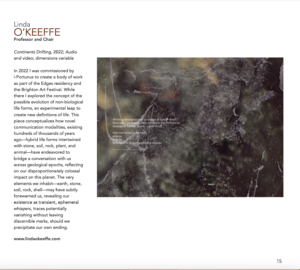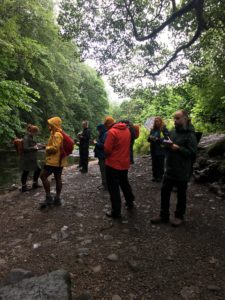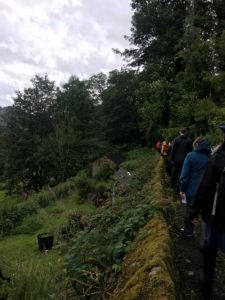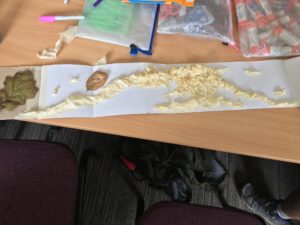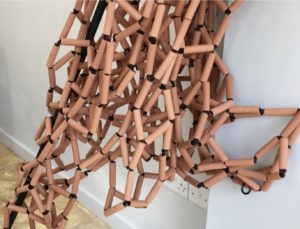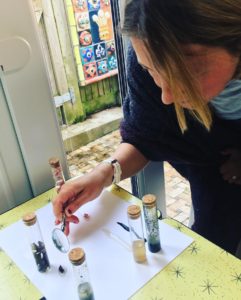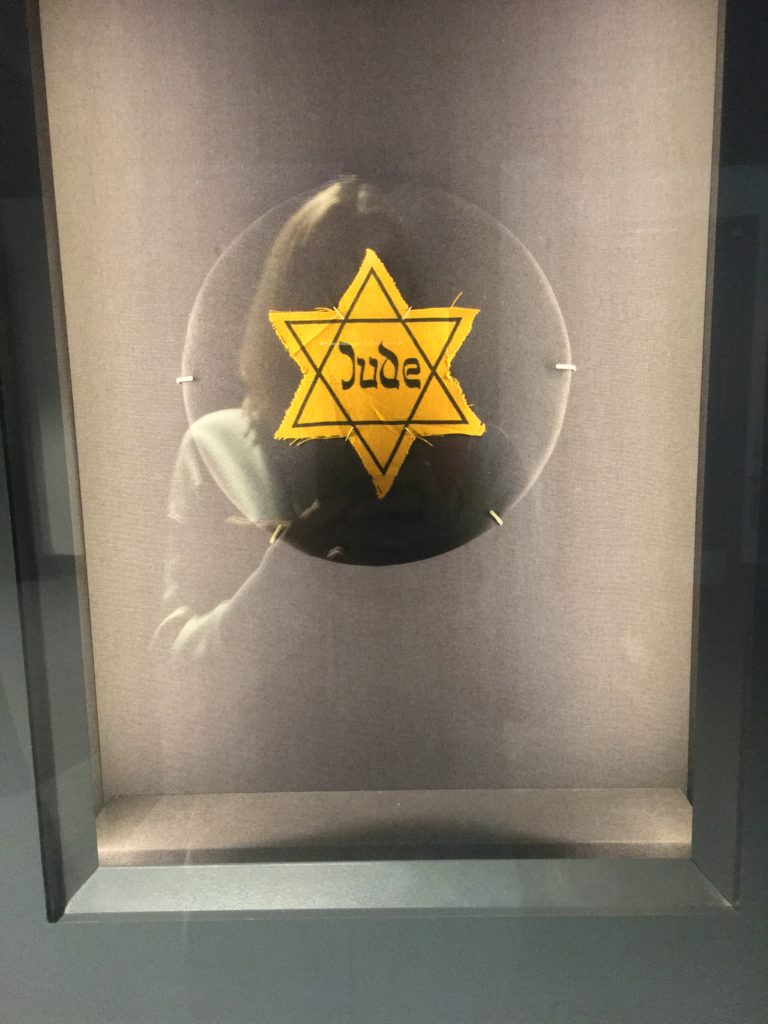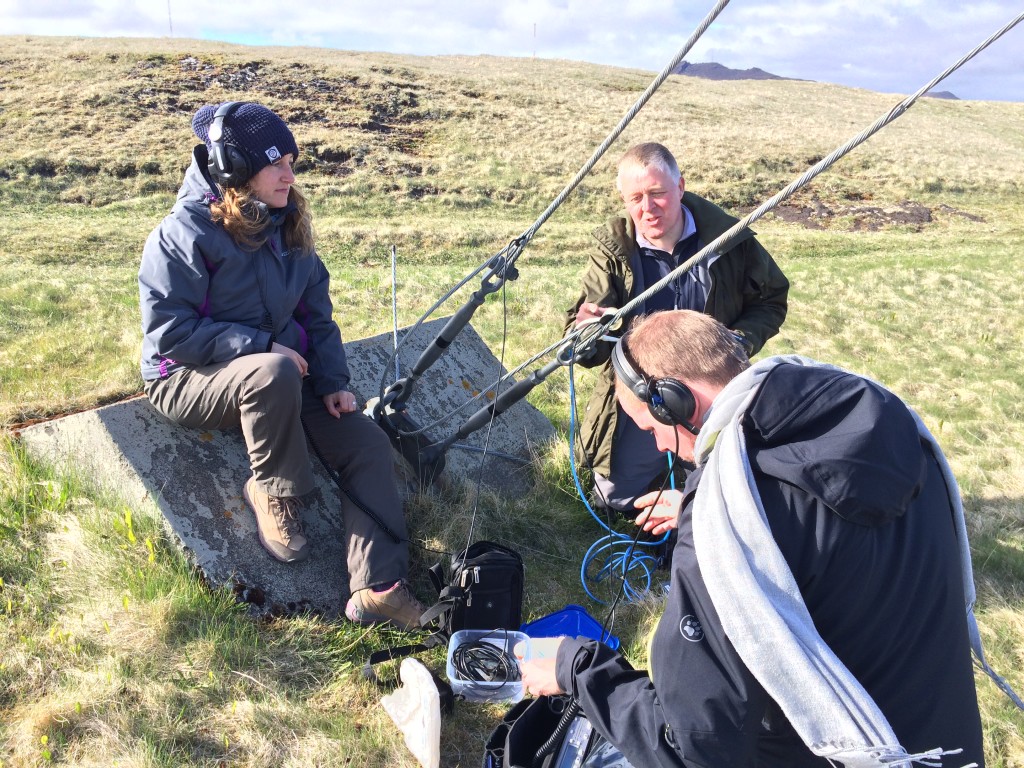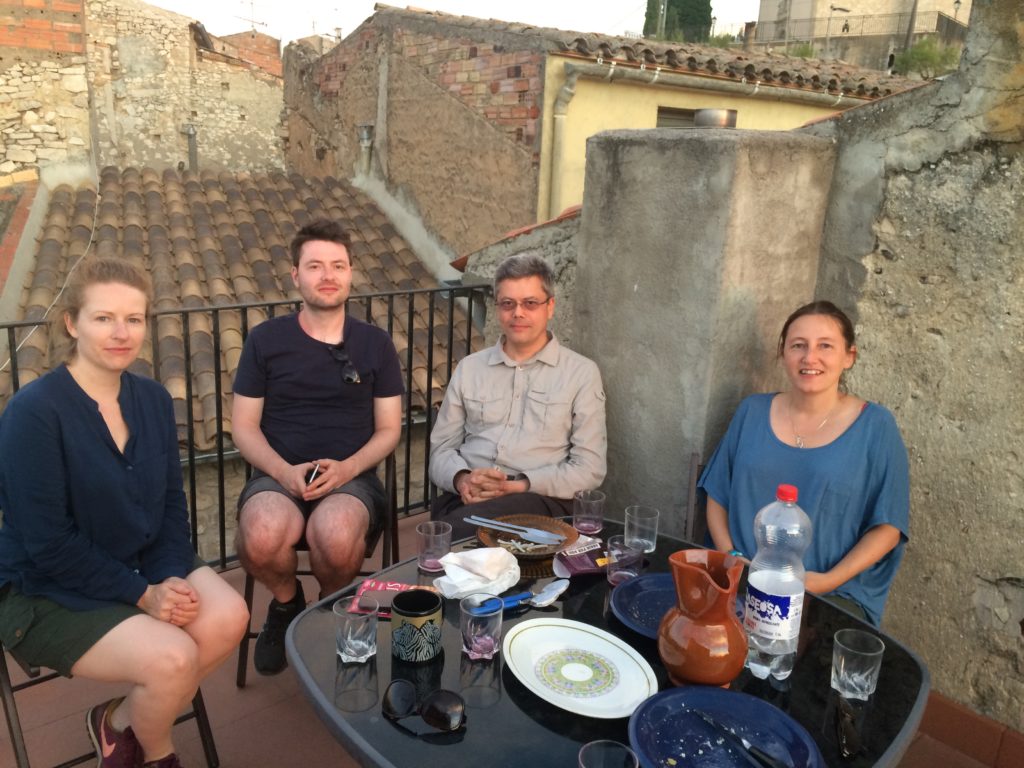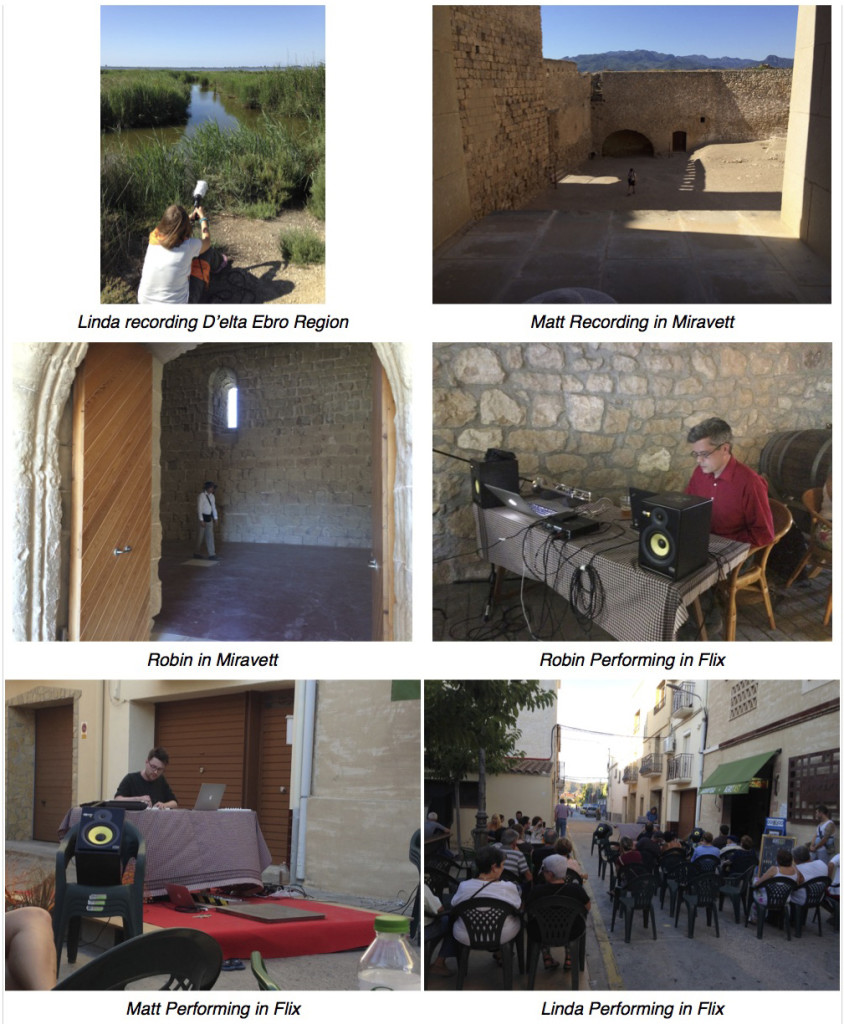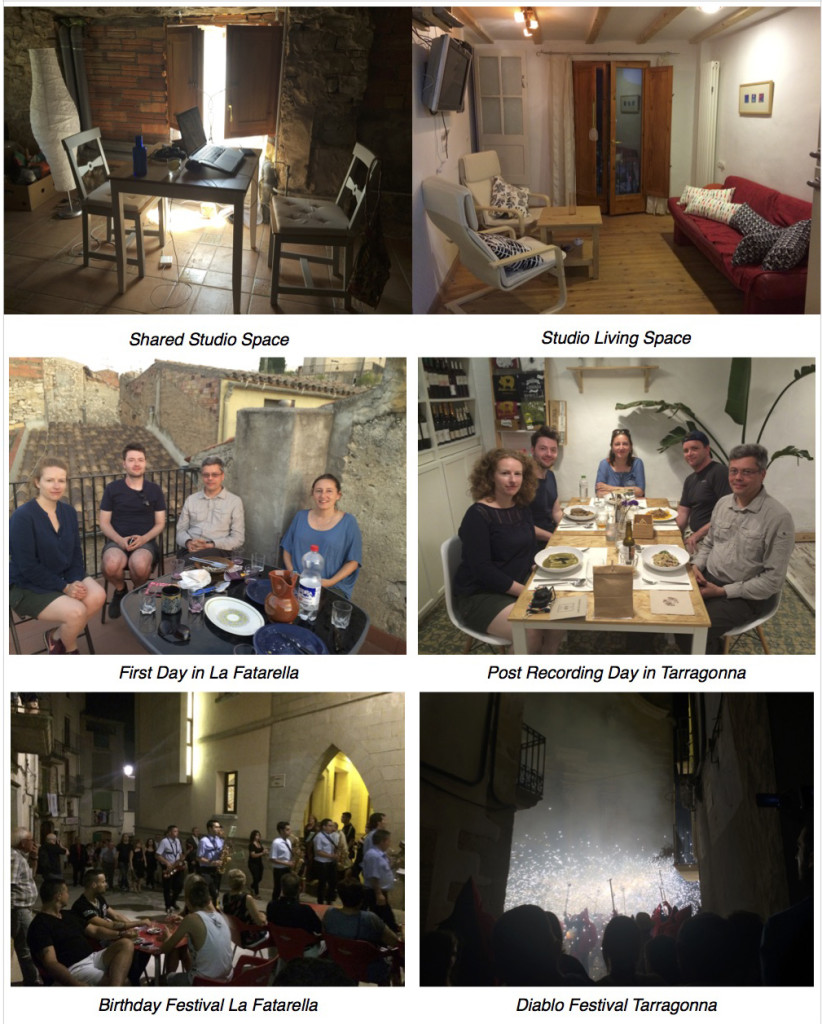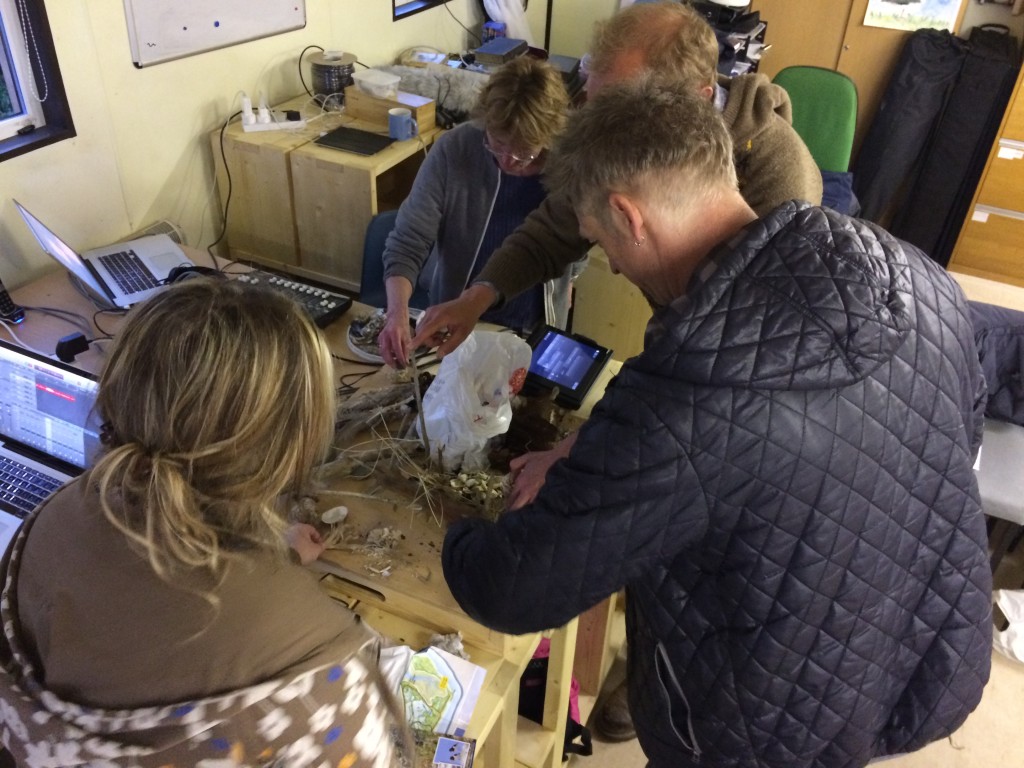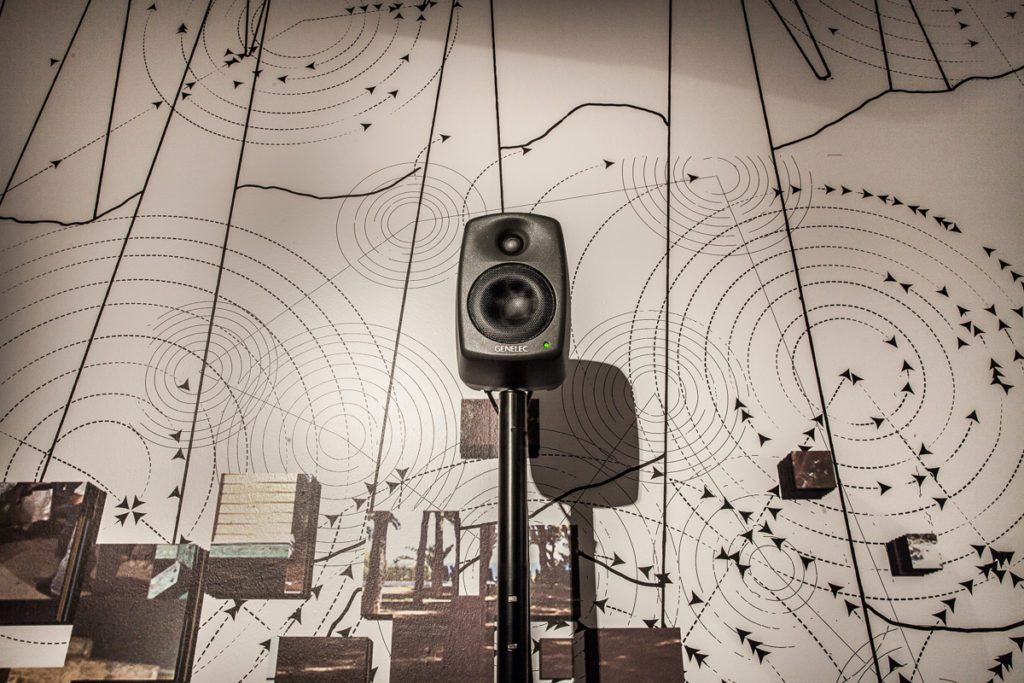Myself and the Non Random Artists collective are at SETI for the next two weeks as artists in residence, we started our residency today, our goal os to explore a variety of themes and concepts related to climate change, habitability, the potential of and ethical use of genetic editing, deep time, interplanetary travel, diseases and the phenomenology of the embodied experiences of human and other than human transformed over time to exists in vastly different environments.
In 2022, I was commissioned by i-Portunus to create a body of work for the Edges residency and the Brighton Art Festival. I engaged in a discursive collaboration with ceramic artist Juss Heinsalu at the Ceramic House Brighton, focusing on the theme of Edges and Peripheries. Supported by Creative Scotland and i-Portunus, this collaboration delved into questions about the nature of life, intelligence, and the anthropocentric nature of these definitions. Their inquiry was an extension of research into the ethics of genetic editing for climate adaptation.
The result was an audio-visual work titled “Continents Drifting.” This piece imagines ancient communication modalities, where hybrid life forms—intertwined with elements like stone, soil, rock, plant, and animal—strive to communicate with us across geological epochs. It reflects on our significant impact on the planet. The work suggests that earth’s elements—earth, stone, soil, rock, shell—might have subtly warned us of our transient existence, which could vanish without a trace if we cause our own demise.
“Continents Drifting” has been showcased at the Alternating Current Festival in Dublin in 2023, the Zuccaire Gallery in New York in 2023, and is scheduled for exhibition at The Wexford Art Centre in Ireland in 2024.
As part of the Hebden Bridge Arts and Ecology Festival Open Space 70, I was asked to create a sgundwlak and sound mapping workshop. I was supported by the amazing Paul Knight, philosopher and land walker, to create a walk that would bring a group of people through a changing landscape of urban, rural and wild, where we would discover the traces of our anthrophony on the bio sphere, and then following this walk create sound maps of this journey. During the walks I introduced my listeners to three female listeners to enhance their listening experience, and to discover different ways of measuring their sonic experience from an ecological, sensory and personal perspective. They were Pauline Oliveros, Hildegard Westerkamp and Rachel Carson. I then explored my own approach to listening developed as part of my research.
Below are some images from the journey as well as some of the amazing maps my participants created. I constructed these little booklets to allow them write some of their experiences on the back, during the walk, and then map on the other side. It was a great day and I am so thankful that being part of the Propeller Ensemble Performance for the same festival allowed me the opportunity to create and run this workshop.
In 2020 I began a conversation with the composer Jack MacNeill of the propellor ensemble. He was interested in the work I had been doing in the field of acoustic ecology and the sound arts, particularly my community engaged approach, my focus on excluded voices, and the way I created outputs from performances, to installations and publications, in order to reach as wide an audience as possible. These conversations struck a real chord, as they allowed me to begin to explore the personal impact the research had on my everyday life. Sometimes to explore difficult topics you step a little outside yourself, perhaps as a coping mechanism. To have such a long and deep conversation allowed for a form of self reflection, and over the course of the past two years, I have placed these thoughts into the performances that Jack and the Propeller Ensemble have created and for which I have been invited to perform alongside with the absolutely amazing ecologist and ornithologist Mark Cocker. So in July this year I performed alongside Mark, Jack and two additional performers from the Ensemble at the Hebden Bridge Festival Open Space 70. We performed together last year at Lancaster Arts, but this felt like an evolution and refinement of how we collaborate on stage. All of this stems from the podcast series Jack created as a result of conversations with a variety of arts, ecologists and theorists, and they are a staggering creation that can be accessed here.
Below is a series of snapshots from that performance, listen through or skip through, but its a lovely piece to watch or listen to.
For best experience listen on headphones, or play on large screen with good speakers, preferably at head height.
In 2022 April, I participated in a collaborative project at the Ceramic House Brighton, with ceramics artist Juss Heinsalu, exploring the concept of Edges and Peripheries. This was supported by funding from Creative Scotland and iPortunus. Through a series of experimental conversations, and text-based communication, we began to ask, ‘what constituted life’, ‘intelligence’, who defined that, and how anthropocentric were our definitions? This was shaped by my own research into using genetic editing, with the Non Random Collective, as an adaptation response to climate change and the ethical implications of that.
What emerged was an idea about how we might take an experimental leap to create new definitions of life, explore new modes of communication, think about how life might have formed many hundreds of thousands of years ago, hybrid forms of life connected to stone, soil, rock, plant, and animal. In response to the theme, I created the film Continents Drifting and Juss, a large scale ceramic work created.
These works are the first in a set or series of works that we will continue to examine going forward, but here is a sample of the works we developed for the Brighton Festival Open House exhibition.
By the second week of my residency in Brighton, myself and my collaborative partner Juss Heinsalu, have begun to explore ideas around the possible evolution of non biological life forms, of moving away from the centering of the human experience for defining life, de-anthropomorphism. We are examining how life forms at the edge, struggling to survive, fighting for every opportunity to exist, procreate, to become a permanent part of an ecosystem.
As humans now live on a precipice, it is 100 seconds to midnight, our very existence is challenged, we wonder how a non human defined entity might try to communicate with us, perhaps a warning of the affects of our behaviour, perhaps they have already warned us, and the slow geological time of communication means we have not heard this communing that has been attempted over thousands of years. We have as Foucault defined, a need to order things, with humans at the top defining and categorising all other forms of life and non living things. Yet our presence here is a matter of seconds in geological time, and while it seems our impact is exponentially greater than it should be for a fragile species, perhaps another entity can remind us that we are a willow the whisp, a trace that might not leave a mark for anyone to explore if we erase our own existence. Perhaps the very earth, stone, soil, rock, shell, that we stand on is/has already warned us.
Our first experiments are to examine the life of soil, sand, rock, remembering how definitions, categorisations of life have changed, evolving with human understandings of what constitutes a biological life form, for example coral as a living breathing life form, a forest as not a space of single trees, but a biodiverse system, mycelium, which connects and communicates and interacts with different species.
Next stages are to give voice/resonance to this communication from geological time, think the Ents and Entish, “You must understand, young Hobbit, it takes a long time to say anything in Old Entish. And we never say anything unless it is worth taking a long time to say.” Lord of the Rings
This research project is funded and supported by i-Portunus and the Ceramic House
As part of my commission with the Huddersfield Holocaust Museum I created a workshop to explore how you can listen for the soundscape of exclusion and inclusion, racial, class, gendered, how you can map these sounds in particular spaces and then create a composition in the form of a graphic score. This workshop included two lectures and a sound walk around Huddersfield, it was snowing just before we left, but the sun and the birds came out just for our walk.
Paying attention to the sounds around us can often make audible audible forces which are intent on creating division in society. Opening our ears to these sometimes subtle, insidious voicing’s and soundings mean we become aware, before it moves in to the visible, of the potential of certain groups acting to creating divides between people and cultures. The Holocaust Museum is a perfect example of how ignoring the mutterings, closing our ears to prejudice, violence, lies, can lead to the most horrific acts humans can perform.
Some wonderful experiences on our walk and in the museum exploring how we can collectively map soundscapes, and creatively transform these maps in scores for potential performances. Some amazing stories emerged in this workshop about personal experiences, which were then mapped to the graphic scores.
In January 2022 I began to develop a commission of sound work under the heading audio guides, for the Holocaust Exhibition and Learning Centre in Huddersfield. I will spend the next several months working with archived interviews, and recording interviews with survivors and reading a lot of work on the Holocaust, in order to develop this body of work. Currently working my way through Peter Hayes Why? Explaining the Holocaust, which is a brilliant book presenting the statistical facts of the time period to counter the narrative that was developed in order to create, what was in essence, a race war.
As for building a soundscape that reflects the museum exhibition, which is also an aesthetic and conceptual body of work, this has been a difficult thought to process, how can I create an art work that reflects what I think but does not in any way make light of this experience.
In 2015 myself and the composer Tony Doyle began a journey through different soundscapes to explore the impact of renewable energy technologies on rural and natural environments. This included travelling to a variety of areas, working with local artists and communities, developing new methodologies and producing, albums, exhibitions, concerts and published papers in the process. What follows below is aspects of that research and the outputs as a series of captured blogs and links to outputs.
Icelandic Recording trip 2015
Travelling to Iceland with Christ Watson to record the Icelandic soundscape in the summer cycle, 24 hours of daylight. Some amazing sounds and scenery. Some interference from planes, tour boats and tourists. Visited a hydroelectric dam, emerged feeling perturbations from the very loud underground vibrations of the plant, recorded the sounds underwater in the river.
Recording in Spain August 2015
This summer myself and Tony travelled to the North East of Spain in the Cataluna region, we were hoping to record the hot soundscape as an opposition to the my cold sounds of Iceland. instead of focusing on what heat does do the sounds of nature, which I did actually explore, we came across a very changed landscape to one we had seen almost 8 years before. The skyline of the Terra Alta region, a spectacular mountain area which is located within the Ribera d’Ebre region, was covered in wind turbines. This beautifully large and graceful machines for harnessing the wind, came to dominate my recordings, images of which can be seen above. The sounds they produced was also amazing, and one wonders how much this affects the wildlife. There is a constant whir, whir, whir, which is hypnotic. These sounds alongside my recordings of the electric energy of Iceland will be intriguing material to work with for the next year.
Acoustic Ecology and Sound Recording Residency – Terra Alta Region, Northern Spain August 2016
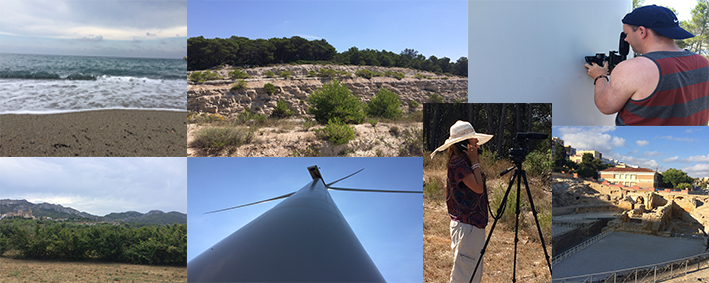
10-day field recording trip in La Fatarella Spain – 9th-19th of August 2016.
Acoustic Ecology Residency 2016
In August 2016 sound artist Linda O Keeffe and Composer Tony Doyle ran a sonic arts residency in the La Fatarella municipality in the northern Terra Alta of Spain. The village is located within a vast mountainous area. During the summer the high temperatures parch the landscape, riverbeds dry up and fallen leaves and branches quickly turn brittle. The surrounding area consists of Finca’s (A piece of rural land, which typically has a farmhouse or cottage present). During the day crickets dominate the soundscape and at night the swallows.
2016 Sound Artists in Residence
The two residents were Robin Parmar and Matt Green.
Robin Parmar explores the poetics of place and memory by way of electroacoustic composition, non-ideomatic improvisation, experimental texts, and film. Works have appeared in Ireland, England, Portugal, Spain, Germany, Sweden, Slovenia, Canada, and the USA. His compositions have appeared on several international labels. Albums include “…between…” (Gruenrekorder, 2014) with David Colohan of United Bible Studies, and “The Drones” (Stolen Mirror, 2013). Recent papers have examined the phenomenology of discontinuity in digital music, the “space” of Joy Division, and the screendance of Angela Conway. Robin lectures on Acoustics, Psychoacoustics, and Modalities of Listening at the University of Limerick. He is a doctoral student at De Montfort University, Leicester.
Matt Green is a lecturer, researcher and site-specific sound artist who holds a Phd in Sonic Arts. Matt’s previous practice includes Resounding Rivers (2010), which was commissioned by Belfast City Council and PLACE, Belfast and explored Belfast’s buried waterways via six concurrent sound installations housed externally throughout the city. In Hear, Out There: Madrid (2008) was a mobile sound work that addressed a culturally impoverished site in Madrid known as AZCA. For this work, Matt and his collaborators received a Spanish Ministry of Culture ‘Culturas 2008’ award. Each of Matt’s installations and mobile works, including those mentioned, are the outcome of an extensive programme of situated activity that includes field recording (the aural equivalent to photography and documentary); community collaboration; and onsite research, design and development.
During the residency we toured the Terra Alta region and the Ebro D’elta, in addition we got to experience festival season in the Tarragonna Region which happens every August. Over the coming months I will update on works created in response to the residency.
Dawn Chorus 7th May 2017 South Walney Nature Reserve
Dawn Chorus on South Walney Nature Reserve from Linda O Keeffe on Vimeo.
As part of International Dawn Chorus Day May 7th 2017 myself and Tony Doyle began a series of recorded walks starting at 4:30 this morning, through the South Walney Nature Reserve in Barrow. There are several distinct nesting sites on South Walney which means you have very different bird sounds as the dawn progresses.
I am not an ornithologist so all I can say for certain is that I have the bird sounds of Great Black-backed Gull, Lesser Black-backed Gull, Herring Gull, Greenshank, Redshank, Short-eared Owl, Eider duck, Canada Goose. The recordings were made in grassland, coastal and pond sites.
Eager ears with more knowledge than me will be able to name the other species.
Performing in Walney May 2017
As part of world Dawn Chorus Day myself and the composer Tony Doyle created a day long workshop for attendees of the Sound Camp at South Walney Nature Reserve, organised by Octopus Collective.
In the evening we performed a new work generated by text performed by the attendees of the sound camp and collected objects.
After a brief introduction to acoustic ecology and listening methods each participant was given a listening meditation (meditation and composition). They brought this on their walks through the reserve. Later, we recorded their texts and a series of sound performances they created with materials they collected as part of the listening meditation and object collection. These were incorporated into a live coded and 3d graphic score performance, see image above.
This performance was broadcast online and performed at the London sound camp. We will have sound and images of the evenings performance to follow.
Presenting papers and artwork at Balance UnBalance Plymouth 2017
This year I presented two papers and and an art work at the balance unbalance conference at Plymouth university. You can download the paper to here.
Listening To Ecological Interference: Renewable Technologies And Their Soundscapes
Abstract
(This proposal is linked to an art proposal for the conference)
The sounds of modernity are increasingly moving into natural habitats. With an influx of new technologies designed to utilise and extract material from nature, the natural soundscape is becoming masked by the mechanical and technological. This article addresses an experience of listening and recording which took place in the summer of 2015, within two different natural landscapes: the southern region of Iceland and the north eastern region of Spain. The field trip exposed a significant keynote sound within each space; a sound produced by renewable technologies. The sounds produced by these technologies, wind farms and hydroelectric power stations, were significantly louder than had been expected. This lead to an analysis of whether the soundscapes of environmentally friendly technologies can or should be critiqued, even if they have a demonstrable impact on the ecosystem.
SOUNDS LIKE HER: HYBRID SOUNDSCAPES I, II, III, IV, 2017

Sounds Like Her (2017), curated by Christine Eyene, produced by New Art Exchange. Photography: Bartosz Kali
In October this year the Sounds Like Her show, curated by Christine Eyene, was launched at the New Art Exchange Gallery in Nottingham. I was one of the commissioned artists in this show which was looking to “broaden existing approaches to sound art, and contest Eurocentric and patriarchal frameworks to sound art” (Eyene 2017). My work, a four wall drawing and sound installation piece, see pics, explored the impact of renewable technologies on the social and natural soundscape.
Each wall drawing is both sound map and graphic score based on four different spaces I have explored over the past 4 years, Beijing, China, Walney in Barrow, UK, The Terra Alta Region in Spain and Iceland. The sound work a 5 .0 piece was spatialised by the composer Tony Doyle. The exhibition also featured works by Ain Bailey, Elsa M’bala, Sonia Boyce, Christine Sun Kim and others. It was a privilege to be part of such a far reaching and important exhibition. The work will continue to be exhibited till January 2018 and will then tour to other venues, those spaces TBA.
Silent Spring Album Launch 5 November 2019
Recently released my new solo album Silent Spring with the label Flaming Pines. This work began over three years ago, with each track, (there are three) created as a meta and physical response to embodied sonic arts research. The album info is below for details from the Flaming Pines site, and the link to listen and purchase tracks or the entire album, is also below. Please purchase to support labels like FP, the great Kate Carr who owns this label, is an invaluable member of the sonic arts community and we need people like her.
https://flamingpines.bandcamp.com/album/silent-spring
Listen to the Wire’s Frances Morgan introduce one of the works on air.https://www.mixcloud.com/TheWireMagazine/adventures-in-sound-and-music-hosted-by-frances-morgan/
Silent Spring is a meditation on human and natural sounds, new technologies, and our relationships with other species.
It comprises three pieces Icelandic Reveries, Silent Spring and Strange Birds, composed from recordings taken at a hydroelectric dam in Iceland, wind turbine farms in the Terra Alta region Spain and acts of sounding and listening in the Brazilian Amazon, respectively. The first two pieces reflect on the impact of new renewable energy sources, tracing not only the sonic impact of these structures on other species, but the ways in which the soundscape is able to communicate broader structural and environmental changes associated with the introduction of these technologies. In Terra Alta, in Spain, where Silent Spring was composed Linda writes:
“The introduction of wind turbines has changed the natural soundscape, with the constant presence of their whirring sound. The crickets are louder, the birds quieter, the change in economic practices from farming to wind turbine systems on the landscape has resulted in fewer jobs for young men and women with a radically reduced agricultural economy. The villages become quieter with young people moving to the cities. This work documents the different spaces of sound in the region from country bars, to festivals, crickets to turbines, it’s a collage of the sounds that are disappearing over time with the emergence of one dominant tech sound.”
While the final piece, which incorporates recordings taken in the Amazon, is centred on listening to the mixed natural and human soundscapes of the Amazon in the state of Amazonas in Brazil, a process which culminated in an act of connection, a scream into the forest, met with screams in return.
credits
released October 14, 2019
All tracks by Linda O’Keeffe
and Mastered by Tony Doyle
Photography and design: Kate Carr
Special thanks: I would like to acknowledge the support of arts council England in developing the work Strange Birds. A special thanks also to Rebecca for screaming with me in the dark.
I would also like to thank Tony Doyle for doing the final mastering of these audio tracks, for listening to every iteration, and giving amazing feedback.
This piece was commissioned for the Myriad Materialities Conference, 9th June 2021, for University of Oxford’s CPAGH (Colonial Ports and Global History) Network
This work examines the way in which a language or sound evolves, becomes transmuted, muted or disappears as it moves beyond the centre, or source of its origin as a result of colonial transformations and post-colonial forgetting.
Growing up in Ireland I resisted having to learn Irish in school, I didn’t understand the point, no one I knew spoke Irish, the common tongue was English, and there was nowhere in the world where having this language would benefit me. I felt a similar antipathy towards Irish music, it felt commodified, created for tourism, a specialised sound for a particular audience. Nothing to do with me. However, when I visited the Gaeltacht regions in Ireland, or heard spoken Irish in a bar, I felt a pull, an envy, an anguish, a loss at not being able to speak or understand my own language. I have felt, in recent years, as an economic migrant, the same experience towards the sound of my culture, from music to poetry, to prose. In researching for this commission, I have explored the history of my language and culture as it has spread from the centre, moving across borders as we left for work, for safety, for independence. When we think of things transported across water, across land, brought to different countries, we focus on things, objects and goods, but there are other kinds of materiality’s, which move from port to port. Language and sound are a part of these myriad materials that when forced to move, either evolve or merge with other cultures, or over time and across space, disappear. I worked with the composer and musician Tony Doyle to develop this piece for the CPAGH commission.
I would like to thank those who have supported the development of this art work, William Howard Lecteur de Gaélique from the Université de Bretagne Occidentale, who has an encyclopaedic knowledge of the history and evolution of the Irish Language, Dr Clare Downham and Dr Eoghan Ahern from The University of Liverpool’s Institute of Irish Studies, for facilitating in the translation of text from English to Irish, and to the composer and performer Tony Doyle for performing the sounds and music for this piece. I also want to thank those who have contributed their voices across time and space, to this work.







